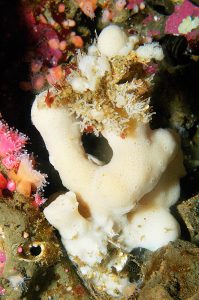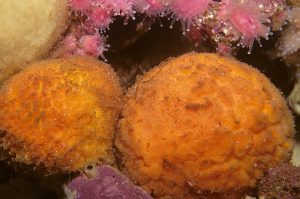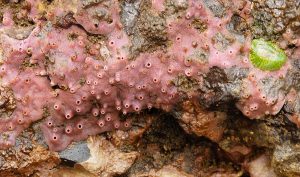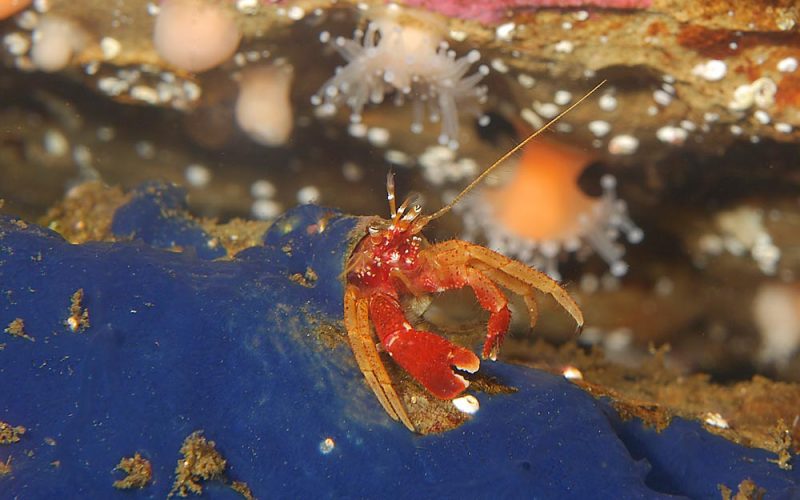
Story and photos by Joanne Carroll-Huemoeller
We have a surprisingly large number of sponges in our Pacific Northwest waters and they seem to thrive.
Using the words primitive and complex in the same phrase, as in the title of this article, rings of an oxymoron. Sometimes, however, things are not what they seem.
Sponges are members of the phylum Porifera, an ancient group of invertebrates. Science denotes sponges as the most primitive of all multicellular animals and possibly the first multicellular organism. A Woods Hole evolutionary biologist, Mitch Sogin, discovered that all multicellular animals originate from the common genetic blueprint of a sponge, making the sponge the foundation of all animal life.
Sponges have no organs, no tissues, and no nervous system. All bodily needs are tasked to individual cells. These simple traits and the sponge’s ancient origins satisfy the first half—the primitive half—of the oxymoron equation.

to a diameter of 6 to 8 inches and are often found in small clusters
of two or three
The equation’s second half explores the complexity of these animals. Sponges as a whole are a thriving group. There are many thousands of sponge species, with more waiting to be discovered. Some resemble giant vases or large baskets, others a strange configuration of finger-like projections. Some are encrusting, with no obvious form or shape, and others are upright. Their color ranges from vibrant red and cobalt blue to pale pink and creamy white.
Their measurements vary just as dramatically. Some sponges are measured in feet, sometimes many feet. In 2015, a National Oceanic and Atmospheric Administration (NOAA) expedition discovered a mini-van sized sponge measuring 12 feet in length and 7 feet high. That contrasts markedly with those measured only in inches.

All the world’s oceans host sponges, from warm, tropical waters to icy, arctic habitats. You can find them in tide pools and on boat docks. Remotely operated vehicles can find them in deep ocean trenches.
Surprisingly, with all these variables, sponge species still share some commonality. The majority of sponges are marine and all are aquatic. Sponges are sessile, meaning they cannot move around. All but a few feed on prey suspended in the water column.
To truly understand the beauty of a sponge, you must first understand its physical characteristics. The skeleton, which supports the body shape, is made up of tiny, pointed and interconnected structures called spicules. Spicule shape and composition varies by species and each is secreted by a single cell.

The body wall is peppered with ostia, or tiny pores. The body interior is a maze of complex canals and chambers. The canal and chamber walls are lined with cells with threadlike appendages called flagella. The flagellum’s swirling movements create a current, which draws water and oxygen in through the pores. The current circulates throughout the body and emerges back into the sea through much larger apertures called oscula, taking with it waste products.
The sponge’s diet includes detritus, small phytoplankton, and dissolved organic material and bacteria, all suspended in the river of seawater flowing through their bodies. Keep in mind that all these food items are small, due to the tiny pores they must pass through. The carnivorous harp sponge, discovered by Monterey Bay Aquarium Research Institute scientists at depths of more than 10,000 feet below the ocean surface, is the exception. Not bothering to filter, this sponge takes a completely different approach to feeding. Equipped with external barbed hooks, the harp sponge, named for its harp-like appearance, snags its prey, usually small crustaceans, as they swim or drift by.
Sponge reproduction is accomplished both sexually and asexually. Eggs are typically fertilized within the sponge body by sperm conveyed in with the current. Fertilized eggs develop into swimming larvae and later settle out to become new sponges. Asexual reproduction is accomplished through cloning, budding, and regeneration.
Sponges are important ecologically as a food source for other invertebrates such as limpets, nudibranchs, snails, sea stars, and chitons. Turtles and some fish are also known to feed on sponges, but they are not completely vulnerable. Their chemical defenses are meant to discourage predation and overgrowth. These chemicals are of great interest to scientists looking for new drugs and cures.
Then there is this final argument on the side of complexity. If a sponge is put through a sieve and its cells separated, the individual cells recognize each other, come together, and begin the process of forming a new sponge. No other plant or animal can regenerate itself this way.
So, although sponges are primitive, they exemplify how even a simple life form can be unexpectedly complex. What appears to be an oxymoron is really more a paradox.
This story appeared in the Winter 2019-2020 issue of Oregon Coast magazine.




